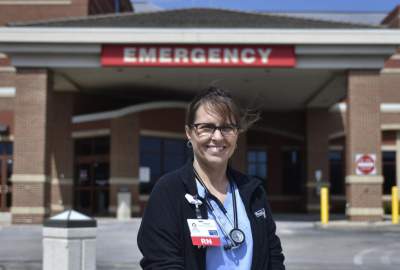Editor’s note: In the past year as many as 600 people have been hospitalized for COVID-19 at Froedtert South, according to Linda Wohlgemuth, senior vice president and chief operating officer. In an interview at Froedtert Pleasant Prairie, we spoke with two nurses who have provided care during this intense year.
The first patients began coming in on March 12, recalls Cheryl Weiss, a nurse in the emergency room at Pleasant Prairie. She noted that in the early days of the pandemic, many patients came in with basic cold symptoms, as not much was yet known about the virus. “They’d get to the emergency department knowing something was wrong, hoping it was just the common cold,” Weiss said. From that moment, “hospital staff basically just dug in,” Weiss said. Early on, symptoms of actual COVID-19 included nausea, vomiting and diarrhea, Weiss said. “By summer more cases presented with respiratory distress and chest pain.”
Kristen Montemurro, an intensive and intermediate care unit nurse at Froedtert since 2007, agreed. She said that one of the hardest parts of the pandemic has been trying to offer hope when it was clear that the disease was progressing and a patient’s condition was deteriorating. “We always want to try to give that point of hope; it’s impossible not to be emotional about it.” “We (as nurses) are invested in hope — that’s why we got into this profession,” Montemurro said. To keep spirits up for family and patients, nurses went above and beyond to keep them all connected, Weiss said. “We helped them stay in touch over the phone because it was hard to offer them comfort.”
“The most challenging thing was the uncertainty. When CDC recommendations kept changing, we had to adjust to how to care for people,” Weiss said. And although it seemed like they had “1,000 things” to learn, “it was wonderful to see how the staff made adjustments in critical thinking,” she said.

Kristen Montemurro
Creative use of resources
Often staff innovated things on the fly like “an intubation quick bag” with supplies needed to care for increasing numbers of patients in a short amount of time.
“This and other ideas are tools we will keep after this is over,” Weiss said. “The pandemic made us more efficient and responsible with equipment,” said Montemurro. “The theme of the year was ‘creative use of resources.’”
Collaboration
The nurses also highlighted “the powerful coordination of community resources” to keep everyone in the loop on the latest information. They had “table talk” meetings that included the fire department, police department and government officials.
Internally, weekly departmental updates by hospital administration were important because every decision impacted so many areas including housekeeping and central supply, Montemurro said. In another example of pulling together, the wound care department offered various skin lotions to staff whose faces had developed a sensitivity from wearing masks for hours on end. “There were so many areas where things came together and just brightened the day,” Weiss said.
Many hospital staff were redeployed from their usual assignments to pick up additional workloads or to cover for staff who had chosen to stay home with their children, Weiss said. Others who had retired volunteered to come back to work. “People didn’t know what they could do and they wanted to help,” Weiss said.
“It was a year!” exclaimed Weiss and Wohlgemuth in unison.
Community outpouring
The nurses all celebrate the support they have received from all directions. “When we were out in the community people thanked us for what we do,” Weiss said.
Wohlgemuth cited a community drive-by during which cars came by the hospital honking and flashing their lights in support of the staff. “It was all so uplifting,” Weiss said. “We always knew how important healthcare workers were, but these things took heroes to a new level,” Montemurro said.
Family support
The nurses were also reminded of the critical role family play in the well-being of patients and how this became strained by the pandemic. “Patients need to be uplifted by their families, and one of the biggest challenges was telling families they couldn’t visit,” Weiss said. “The nursing staff often became a substitute for family,” added Montemurro.
Weiss has five adult children and six grandchildren. One of her daughters also works in the hospital’s emergency department.
Montemurro who has three boys, ages 7, 9 and 10, teared up as she said she could not have made it through this past year had it not been for the at-home help offered by her mother-in-law Rosa Montemurro. Adding that her faith also helped, she said, “God’s bigger than the coronavirus.”
Cheerleaders
Because getting patients well enough to return home is always their goal, early on hospital staff suggested a unique way to celebrate the success of survivors.
With a patient’s permission, staff call out a ‘Code Rocky’ and play the theme song from the movie ‘Rocky’ over the loudspeakers as he or she leaves the hospital, Weiss said. “Staff members from many departments and services line up along the patient’s pathway to the door to honor and cheer the patient on to his or her next phase of recovery,” Wohlgemuth said.
The send-off is a reminder that fighting COVID is a team effort, said the nurses. “There has been so much fear, and so much good, and we have all been in it together,” Weiss said.
